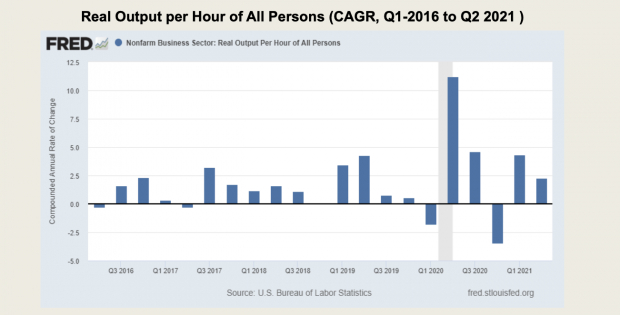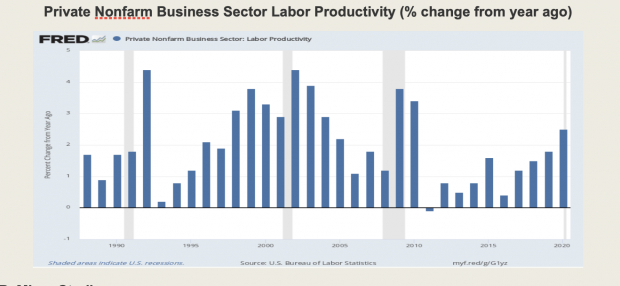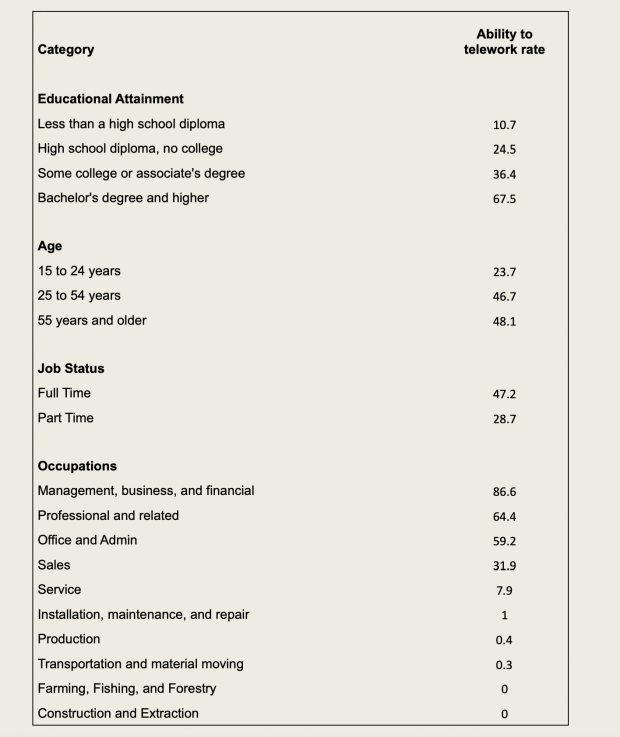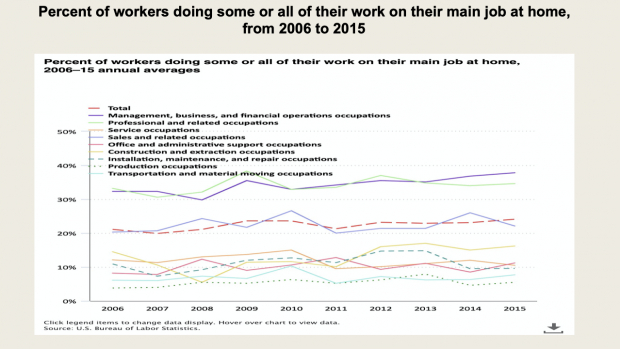This is an excerpt from our most recent Economic Outlook report. To access the full PDF, please click here
According to Upwork in December 2020, 41.8% of the American workforce worked remotely. An estimated 26.7% will still be working from home across 2021, and 36.2 million Americans (22% of the workforce) will be working remotely by 2025.
This is a staggering +87% increase from the number of remote workers prior to the pandemic!
Research shows that businesses lose $600 billion a year to workplace distractions, and that remote workers are 35% to 40% more productive than their in-office counterparts.
Did this remote work shift show up in the U.S. macro productivity figures?
According to the latest data from the U.S Bureau of Labor Statistics, the answer looks like yes.
A. Macro Data
U.S. labor productivity, measured as nonfarm workers’ output per hour, rose +2.3% at an annualized rate in Q2, after rising +4.3% in Q1-2021.
Only during last winter’s deep COVID spike has this quarterly productivity figure been negative, since the start of the COVID pandemic.
Look back across quarterly data running back to 2016, and it seems clear: there has been a spurt of productivity showing up across the U.S. national product accounts.

Image Source: U.S. Bureau of Labor Statistics
However, look into private nonfarm business sector labor productivity over the last 30 years. Three decades of data shows the latest five-quarter spurt is not extraordinary in size, or even unusual.
What appears unusual is the long, slow slog of annual gains in productivity from 2011 to 2019. In that context, remote working productivity gains are just playing catch-up.

Image Source: U.S. Bureau of Labor Statistics
B. Micro Studies
Surveys and researchers are using the data to help understand how working from home can be more productive and enhance working hours.
Apollo Technical has pulled together the evidence from a wide range of surveys that have been done on remote working.
Reports from surveys pulled together by them on Jan. 4th, 2021 show working from home is producing a better turnaround on projects, and increasing productivity.
Great Place to Work compared employee productivity from March to August of 2020, the first six months of stay-at-home orders, to the same six-month stretch in 2019. Remote work productivity was stable or increased when working remotely from home, according to a 2-year study of 800,000 employees.
Prodoscore reports an increase in productivity by 47% since March of 2020 (compared to March and April 2019), and have deciphered when people are the most productive.
The report states workers are the most productive on Tuesday, Wednesday, and Thursday; and between 10:30am and 3:00pm. The average workday still reflects an 8:30am to 5:30pm schedule, and more workers are using emailing and Customer Relationship Management software to stay in contact with co-workers.
A survey by Stanford found that only 65% of Americans had internet fast enough to handle video calls. With 42% of Americans working from home and 26% working at their employer’s physical location.
A survey from March 2020 by Airtasker shows work from home employees spent less time avoiding work (15% difference), spent 1.4 more days working each month, and took more breaks.
Workers in a home environment report they are less distracted by co-workers, spending 30 minutes less talking about non-work topics, and spend 7% less time talking to management.
Companies like Splunk, Affirm and Microsoft saw a large spike in productivity in the first couple of months of quarantine, but over time, the loneliness of working at a home office affects productivity and job satisfaction. This is why many companies are now embracing a hybrid work model.
Several factors are different in a home setting, and these could be the reasons why some workers are more productive at home.
No commute. Whether it takes 10 minutes to drive to work or 1 hour, it saves this time when working from home. Employees can start the workday earlier if they don’t have to take the time to drive into the office. The Airtasker survey reports that, on average, a worker saves 8.5 hours a week of free time by not commuting to work. For a year, this adds up to 408 hours.
Having no commute also means more time for hobbies such as gardening or raising backyard chickens, which have seen an explosion in popularity since 2020.
Less water cooler talk. Those who work from home talk less to coworkers, whether or not it’s work-related. Airtasker reports 70% of people rank work social relationships as important as getting the work done. Working from home minimizes the amount of social interaction.
More Exercise. The lack of commute and less opportunity to socialize allows remote workers to use the extra time to exercise. Regular exercise can be good on mental and physical health and is a great stress reliever. Those who work from home report exercising 30 minutes more during the workweek.
Maximum productivity. A study conducted by Ask.com found that 86% of employees prefer to work by themselves when they are trying to be as productive as possible.
In a Boston Consulting Group study, 75% of employees working remotely report being able to maintain or improve productivity on their individual tasks, and 51% say the same about collaborative tasks.
C. Divergences in Remote Working Experiences
There was a useful remote work survey done by the U.S. Bureau of Labor Statistics in June 2020, called the American Time Use Survey (ATUS). I pulled the following data together from a table that was produced by the B.L.S. researchers.

Image Source: U.S. Bureau of Labor Statistics
As you can see, workers with higher educational attainments, workers who are older, workers that labor full-time, and white-collar professionals are much more able to remote work.
???In that sense, this type of productivity gain is unique. Manufacturing and goods production has typically seen the strongest productivity gains.
The 2020 remote working statistics show these latest productivity gains are from the service sector.
The Bureau of Labor Statistics had looked into the remote working phenomenon prior to the COVID pandemic too. They found the following:

Image Source: U.S. Bureau of Labor Statistics
From 2006 to 2015, “Professional and related occupations” and “Management, business, and financial operations” tracked at around 30% doing remote work.
In the June 2020 BLS survey?
87% and 64%!
In sum, their remote work numbers had indeed more than doubled.
Image: Shutterstock
Did COVID Remote Working Launch Economy-Wide Productivity Gains?
This is an excerpt from our most recent Economic Outlook report. To access the full PDF, please click here
According to Upwork in December 2020, 41.8% of the American workforce worked remotely. An estimated 26.7% will still be working from home across 2021, and 36.2 million Americans (22% of the workforce) will be working remotely by 2025.
This is a staggering +87% increase from the number of remote workers prior to the pandemic!
Research shows that businesses lose $600 billion a year to workplace distractions, and that remote workers are 35% to 40% more productive than their in-office counterparts.
Did this remote work shift show up in the U.S. macro productivity figures?
According to the latest data from the U.S Bureau of Labor Statistics, the answer looks like yes.
A. Macro Data
U.S. labor productivity, measured as nonfarm workers’ output per hour, rose +2.3% at an annualized rate in Q2, after rising +4.3% in Q1-2021.
Only during last winter’s deep COVID spike has this quarterly productivity figure been negative, since the start of the COVID pandemic.
Look back across quarterly data running back to 2016, and it seems clear: there has been a spurt of productivity showing up across the U.S. national product accounts.
Image Source: U.S. Bureau of Labor Statistics
However, look into private nonfarm business sector labor productivity over the last 30 years. Three decades of data shows the latest five-quarter spurt is not extraordinary in size, or even unusual.
What appears unusual is the long, slow slog of annual gains in productivity from 2011 to 2019. In that context, remote working productivity gains are just playing catch-up.
Image Source: U.S. Bureau of Labor Statistics
B. Micro Studies
Surveys and researchers are using the data to help understand how working from home can be more productive and enhance working hours.
Apollo Technical has pulled together the evidence from a wide range of surveys that have been done on remote working.
Reports from surveys pulled together by them on Jan. 4th, 2021 show working from home is producing a better turnaround on projects, and increasing productivity.
Great Place to Work compared employee productivity from March to August of 2020, the first six months of stay-at-home orders, to the same six-month stretch in 2019. Remote work productivity was stable or increased when working remotely from home, according to a 2-year study of 800,000 employees.
Prodoscore reports an increase in productivity by 47% since March of 2020 (compared to March and April 2019), and have deciphered when people are the most productive.
The report states workers are the most productive on Tuesday, Wednesday, and Thursday; and between 10:30am and 3:00pm. The average workday still reflects an 8:30am to 5:30pm schedule, and more workers are using emailing and Customer Relationship Management software to stay in contact with co-workers.
A survey by Stanford found that only 65% of Americans had internet fast enough to handle video calls. With 42% of Americans working from home and 26% working at their employer’s physical location.
A survey from March 2020 by Airtasker shows work from home employees spent less time avoiding work (15% difference), spent 1.4 more days working each month, and took more breaks.
Workers in a home environment report they are less distracted by co-workers, spending 30 minutes less talking about non-work topics, and spend 7% less time talking to management.
Companies like Splunk, Affirm and Microsoft saw a large spike in productivity in the first couple of months of quarantine, but over time, the loneliness of working at a home office affects productivity and job satisfaction. This is why many companies are now embracing a hybrid work model.
Several factors are different in a home setting, and these could be the reasons why some workers are more productive at home.
No commute. Whether it takes 10 minutes to drive to work or 1 hour, it saves this time when working from home. Employees can start the workday earlier if they don’t have to take the time to drive into the office. The Airtasker survey reports that, on average, a worker saves 8.5 hours a week of free time by not commuting to work. For a year, this adds up to 408 hours.
Having no commute also means more time for hobbies such as gardening or raising backyard chickens, which have seen an explosion in popularity since 2020.
Less water cooler talk. Those who work from home talk less to coworkers, whether or not it’s work-related. Airtasker reports 70% of people rank work social relationships as important as getting the work done. Working from home minimizes the amount of social interaction.
More Exercise. The lack of commute and less opportunity to socialize allows remote workers to use the extra time to exercise. Regular exercise can be good on mental and physical health and is a great stress reliever. Those who work from home report exercising 30 minutes more during the workweek.
Maximum productivity. A study conducted by Ask.com found that 86% of employees prefer to work by themselves when they are trying to be as productive as possible.
In a Boston Consulting Group study, 75% of employees working remotely report being able to maintain or improve productivity on their individual tasks, and 51% say the same about collaborative tasks.
C. Divergences in Remote Working Experiences
There was a useful remote work survey done by the U.S. Bureau of Labor Statistics in June 2020, called the American Time Use Survey (ATUS). I pulled the following data together from a table that was produced by the B.L.S. researchers.
Image Source: U.S. Bureau of Labor Statistics
As you can see, workers with higher educational attainments, workers who are older, workers that labor full-time, and white-collar professionals are much more able to remote work.
???In that sense, this type of productivity gain is unique. Manufacturing and goods production has typically seen the strongest productivity gains.
The 2020 remote working statistics show these latest productivity gains are from the service sector.
The Bureau of Labor Statistics had looked into the remote working phenomenon prior to the COVID pandemic too. They found the following:
Image Source: U.S. Bureau of Labor Statistics
From 2006 to 2015, “Professional and related occupations” and “Management, business, and financial operations” tracked at around 30% doing remote work.
In the June 2020 BLS survey?
87% and 64%!
In sum, their remote work numbers had indeed more than doubled.